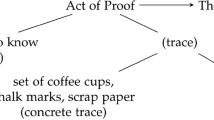Abstract
The notion of ‘obvious’ inference in predicate logic is discussed from the viewpoint of proof-checker applications in logic and mathematics education. A class of inferences in predicate logic is defined and it is proposed to identify it with the class of ‘obvious’ logical inferences. The definition is compared with other approaches. The algorithm for implementing the ‘obviousness’ decision procedure follows directly from the definition.
Similar content being viewed by others
References
Blaine, Lee, ‘Programs for Structured Proofs’, in University-Level Computer-Assisted Instruction at Stanford: 1968–1980, Patrick Suppes (ed.), IMSSS Stanford University, 81–119 (1981).
Chang, Chin-Liang and Lee, Richard Char-Tung, Symbolic Logic and Mechanical Theorem Proving, Academic Press, New York, NY (1973).
Davis, Martin, ‘Eliminating the Irrelevant from Mechanical Proofs’, in Proc. Symp. Appl. Math., vol. 15, 15–30 (1963).
Davis, Martin, ‘Obvious Logical Inferences’, Proceedings of the 7th IJCAI, Vancouver, 530–531 (1981).
Garson, James and Mellema, Paul, ‘Computer-Assisted Instruction on Logic: EMIL’, Teaching Philosophy, 453–478 (1980).
Ketonen, Jussi, EKL—A Mathematically Oriented Proof Checker', in 7th International Conference on Automated Deduction, R. E. Shostak (ed.), Napa, 65–79 (1984).
Los, Jerzy, Personal communication (1983).
Marinov, Vesko, Personal communication (1980).
Prazmowski, Krzysztof and Rudnicki, Piotr, MIZAR MSE Primer, ICS PAS Report No. 529, Warsaw (1983).
Quine, W. V. O., Methods of Logic, Holt, Rinehart and Winston, Inc. (1972).
Rudnicki, Piotr and Drabent, Wlodzimierz, ‘Proving Properties of Pascal Programs in MIZAR 2, Acta Informatica, 311–331, 699–707 (1985).
Schagrin, Morton L., Rapaport, William J. and Dipert, Randall R., Logic: a Computer Approach, McGraw Hill Book Company (1985).
Smith, R. L., Graves, W. H., Blaine, L. H. and Marinov, V. G., ‘Computer-Assisted Axiomatic Mathematics: Informal Rigor’, in Computers in Education, O. Lecarme and R. Lewis (ed.), North Holland/American Elsevier, 803–809 (1975).
Trybulec, Andrzej, ‘The MIZAR-QC/6000 Logic Information Language’, Bulletin of the Association for Literary and Linguistic Computing, 136–140 (1978).
Trybulec, Andrzej, Personal communication (1981).
Trybulec, Andrzej, Unpublished report, University of Connecticut (1984).
Weyhrauch, R. W., ‘Prolegomena to a Theory of Mechanized Formal Reasoning’, Artificial Intelligence 12, 133–170 (1980).
Wos, L., Veroff, R., Smith, B. and McCune, W., ‘The Linked Inference Principle II: The User's Viewpoint’, in 7th International Conference on Automated Deduction, R. E. Shostak (ed.), Napa, 316–332 (1984).
Author information
Authors and Affiliations
Rights and permissions
About this article
Cite this article
Rudnicki, P. Obvious inferences. J Autom Reasoning 3, 383–393 (1987). https://doi.org/10.1007/BF00247436
Received:
Issue Date:
DOI: https://doi.org/10.1007/BF00247436




